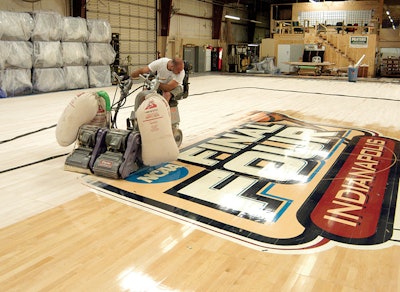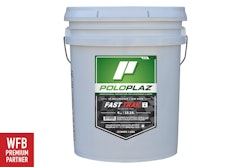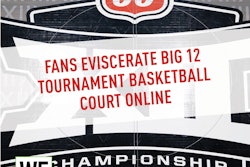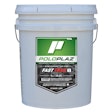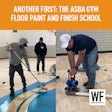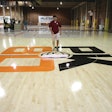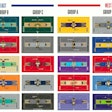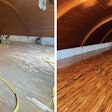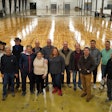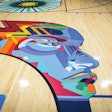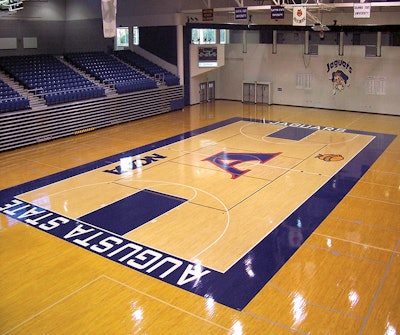
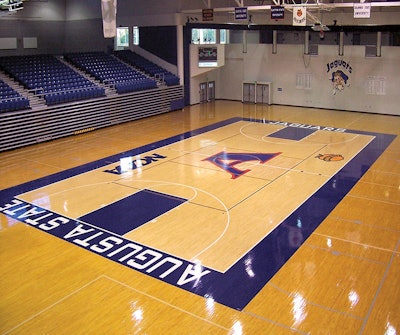
During these slower economic times, many residential wood flooring contractors are looking at any possible option to increase business, and one avenue that might seem appealing is sports flooring.
More money is being put into sports flooring than ever before, as gyms in facilities such as schools, colleges and private clubs become bigger and more elaborate. For a residential contractor used to meticulously edging underneath kitchen cabinets and cutting in finish around kitchen islands, that huge expanse of hardwood at his son or daughter's high school basketball game could look like a gold mine.
That gold mine can turn to fool's gold, however. Square-foot prices charged in the sports flooring market for sanding and finishing can easily be half of the going rate for the residential market, and public projects such as public schools are almost always low-bid. The jobs are much bigger than residential projects, but so are the risks. Most contractors can swallow the extra expense if something goes wrong with their finish job in a living room, but they would take a much bigger hit if they had to refinish an entire gym.
That said, some contractors find sports flooring to be a lucrative business. Sports flooring specialists are trained on the multitude of different gym floor systems available, know how to paint game lines and are dealers for one of the handful of Maple Flooring Manufacturer Association (MFMA)-approved sports flooring manufacturers. The complexity of the systems, the painting, the existing dealer networks and the necessary financial strength are all formidable barriers to entry for new contractors in the sports flooring installation market. Because of that, most who are new to sports floors pursue recoating. If you're thinking of going that route, you need to be familiar with some of the aspects that can make sports floor recoating a whole different ballgame.
Check Out the Job
The industry standard for gym floors is that they are recoated once a year (resanding is usually recommended once a decade). As mentioned, you need to be familiar with the going rate for sports flooring projects in your area. Clients with floors in private schools, churches and private health clubs are more likely to take factors besides price into consideration when choosing a wood flooring contractor.
To be profitable on any gym job, you must be ultra-efficient. And while the finish job on a gym doesn't have to be as meticulous as it is in a home, there are plenty of pitfalls that can slow you down. As with any recoat, you should find out the complete maintenance history on the floor. The job site should be inspected carefully. A few things to consider that are particular to a gym job include:
• Are there damaged boards that need to be replaced? Board replacements on the many different gym floor systems can be different from those on a typical residential job. Will you know how to do the repair?
• Are there areas with paint that need to be repaired? If so, you must be familiar enough with paint to repair it successfully (see "In the Paint" sidebar above).
• How careful have previous contractors been about getting finish on the baseboards and on the plates covering electrical outlets, volleyball pole anchors and other plates in the floor? Will they need to be taped off?
• Is there temporary vinyl sports line tape on the floor, and if so, are the facility maintenance personnel going to remove it, or are you? How long has it been down? Sometimes it comes off easily; sometimes it is old and brittle and labor-intensive to remove. It can leave adhesive residue and usually pulls up the finish. The customer needs to know that areas with missing finish will be visible once the floor is recoated.
Screening the Floor
Before screening can begin, any repairs must be made and the floor must be thoroughly cleaned. First, walk the floor and look for gum and other foreign objects that won't come off with a screen. A dull putty knife or scrapers specifically for this purpose can be used to remove gum.
The traditional cleaning method is to use a push broom with towels saturated with wood flooring cleaner, but increasing numbers of contractors (and gym floor maintenance crews) are using auto-scrubbers instead. These machines spray the floor with cleaner, scrub them with a maroon pad and then vacuum up the moisture as they move across the floor. Because there isn't agreement in the industry on whether they should be used on wood flooring, it's a good idea to check with the finish manufacturer and the wood flooring manufacturer before using one.
Some contractors use a "wetscreen" method, in which they section off the floor, pre-mop the area with cleaner, use a buffer with a pad or screen, then immediately use a wet-vac to remove the moisture.
Screening on a gym floor usually takes longer per square foot than it does on a residential job because of the intense traffic gym floors receive. When they aren't in use for sports, today's gyms are used for everything from flea markets to wedding receptions to dog shows, and many are booked between 48 to 50 weeks out of the year. They can have unusual wear that is difficult (or impossible) to remove, such as long white streaks from baseballs or other marks that are unidentifiable (scroll down to see sidebar for more info).
There also may be previous scuffs and other marks that were coated over by a previous contractor, which obviously won't come out unless the floor is resanded.
Whether the existing finish is oil-modified polyurethane or waterborne, typical screening involves a 120- or 150-grade screen. Screens are used up quickly when continuously going over so many square feet, so pay careful attention to the square footage on the screen. A glossy gym floor should look like satin after screening; if it looks like semigloss, you know your screen needs to be changed. Be aware that because of all the finish build on many gym floors, screen marks tend to be especially visible. Contractors usually wear backpack vacs when screening, which greatly reduces cleanup time; actual DCS systems are not used with gym floors. Whether for budget concerns or other reasons, some facility managers opt for chemical recoating systems instead of screening.
Coating Concerns
Because of concerns about sidebonding or panelization, most new floors are first coated with poly. For recoats, the jobs are more evenly split between poly and waterborne finishes. Whether the facility manager wants a traditional amber look, how long the facility can be shut down for recoating and whether the building will be occupied during the recoating all factor into which type of finish is chosen. Most sports floors have glossy finish, and the finish must be MFMA-approved (meeting requirements set by the MFMA for many factors, including slip-resistance).
In many aspects, finishing a gym is easier than coating a residential job. The floor is usually a huge rectangle, there's no wallpaper or expensive baseboards to avoid and no finicky homeowners pointing out every hair in the finish.
Coating a gym floor takes some strategy, however, and after a certain size, they are nearly impossible to coat alone. To cover ground quickly and help get the right coverage rate, heavyweight 24-inch T-bars are typically used; applicators with a tank on the handle are also available. To save time, finish is usually poured into 5-gallon buckets and set at regular intervals when it will be needed across the floor. Oftentimes, one worker pours finish while another comes behind with the applicator. Or, there may be two people pulling finish in waves—one starts, the next person waits a few seconds, then follows pulling the next row. Whichever method is used, keeping a wet edge is extremely important, as is the strategy for coating the last row and getting off the floor.
One critical factor is the coverage rate. The open expansion joints and the gaps between boards, especially during dry winter months, can swallow the finish, drastically decreasing the coverage rate. Many contractors have been left short while coating a gym floor. If you see you're going to run short on finish, try to stop coating at an expansion joint, which makes a natural division in the floor. If that's not possible, use a tape line at a board edge, just as you would on a residential floor. Don't try to save time by skipping the tape and trying to freehand the finish at a board edge, which always results in an obvious wavy line.
Controlling the job-site conditions when coating a gym can be difficult. Just as with a residential job, you need as little air movement as possible when coating, then air movement once the finish has skinned over. Work with the facility manager to do the best you can with what's available. That could mean anything from a programmable, well-designed HVAC system to a few large ceiling fans to a couple large fans (blowing out) at doorways. Because the ceilings are so high, it can be hard to get enough air exchange to move the solvent out of the space, and there can be uneven air movement—the finish may be cured in one spot but not in another spot 10 feet away. Contractors sometimes coat at night or early in the morning if the job-site conditions are better then.
Fast Fundamentals
While the size and type of the jobs may be different, the fundamentals of sanding and finishing a sports floor are the same as they are with any wood floor. If you are prepared to be efficient while tackling the particularities of gym floors, there is plenty of business to be had and—even with the lower margins in the gym business—money to be made.
Sources and reviewers for this article included Pat Cooney, BonaKemi USA; Bob Gamble, Arbo's Hardwood & Sports Floor Supply; John Prater, Praters Inc.; and G. Brent Sorbet, ProStar Inc.
In the PaintMany people consider painting to be the biggest hurdle to entry in the sports flooring business. Here are a few painting basics: Game lines: Although painting game lines can be a carefully guarded secret (one gym floor contractor was known to teach only family how to do it and would chain the doors shut while it was done), it isn't rocket science. A quick Internet search will reveal directions for marking lines from scratch; the process starts by dropping a plumb line down from the basketball backboard and measuring from there, using a taping machine to mark the lines, which are then painted by hand. Schools including instruction on game lines are occasionally offered by finish or gym floor manufacturers. Even after going to a school, doing game lines takes some practice, so it's best to start small and simple. Paint and Finish: Although it can vary, typical sports floors have two sealer coats, then the paint, then two topcoats. Many of the same principles from staining apply to painting: all finish coats, including the paint, must be given sufficient dry time, and darker paint colors require longer dry times. Gym floors are almost always a rush job, so it's tempting to coat too quickly, and peeling finish over paint is one of the biggest problems with gym floors. The seal coat must be allowed to dry well, or its solvent will try to evaporate through the paint, causing the finish to peel. The sealer must be abraded before paint is applied, and once the paint is applied, it should be allowed to dry before it is abraded, as well. After abrasion, the paint needs more dry time, because abrading opens the paint back up. Using the right paint is important. Some finish manufacturers offer their own game line paints, but for other manufacturers, you'll need to check which paints they recommend. Some paints stick better to sealers and others to finish, so always follow the finish manufacturer's recommendation. Paint Repairs: Even if you aren't doing new installations, a substantial percentage of recoat jobs involve paint repairs, so working with paint is a useful skill. On resand jobs, some contractors use a technique of punching the corners of the existing lines so they don't need to be remeasured from scratch. That runs the risk of duplicating a mistake if the lines were done wrong to start with, though, so it's a good idea to know the measurements and doublecheck. (Links for the correct game line markings dimensions are available at the Maple Flooring Manufacturers Association Web site at www.maplefloor.org; click on the "Game Markings Manual" link.)—K.M.W. |
Sports Specialists
Contractors who specialize in the installation, sanding and finishing of sports flooring need the equipment and the personnel to get the job done as quickly—and therefore as profitably—as possible. The Right Equipment: Riding sanders, which operate two big machines or buffers at once, are a must. One contractor likens sanding a gym floor with a regular big machine to trying to mow a football field with a push mower. Because of the power required, generators are sometimes necessary. Edgers that operate on 220 volts are used, and many gym specialists also use auto-scrubbers. Scheduling: Getting jobs done efficiently is important not only for profitability, but because the crews are often rushing to the next job. The vast majority of sports flooring work is done over school breaks and the summer, so work is scheduled as tightly as possible to get it while it's available. Because the work is seasonal, most of the workers are seasonal, too— often college kids who are available when the jobs are available. Sports floor specialists frequently travel over a wide territory, so many have trailers or vans that are set up as remote living quarters. Finances: Sports flooring contracts can easily be hundreds of thousands of dollars, and for most jobs over $25,000, the contractor must be bonded. For public jobs, the company may also need to meet contractor's licensing requirements and have certified payroll. Payment for the retainage on a large project can be delayed by many months, so companies must be financially prepared to operate without that money. —K.M.W. |











